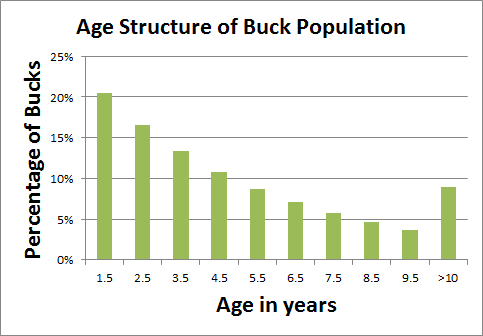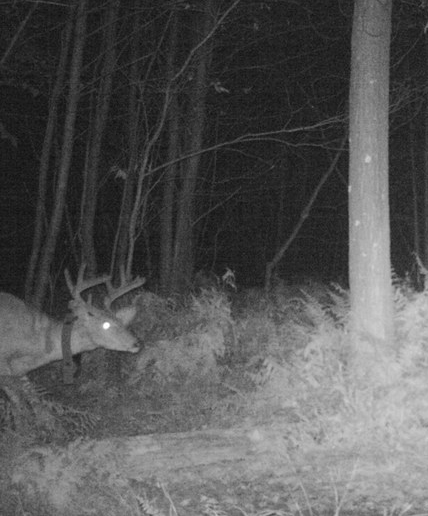The antlered harvest regulations in all four of our study areas require at least 1 antler to have 3 or more points.
Under those regulations, we know that about 36% of yearling (1.5 years old) males are legal for harvest and ~80% of adult males (at least 2.5 years old) are legal. This is why antler point restrictions work. They protect the majority of yearlings from harvest of which 90% survive to the next hunting season.
But if 36% of yearlings are legal to harvest, do all of them get harvested?
To estimate harvest rates in this study, we use a statistical model that was developed by one of my students using data from both radio-collared and ear-tagged only deer. The problem with ear-tagged deer is that we usually don’t know if or when they die (unless they are harvested and reported to us). However, with our radio-collared deer we can estimate whether an ear-tagged deer survives to the hunting season and thus correct for any unaccounted for mortality.
This approach to estimating harvest rates has an advantage: you don’t have to radio-collar and track every deer you capture. Radio-collars are cool and all but they cost a lot of money. And when you are trying to stretch limited research dollars, saving money is a big deal.
From 2013 through 2017 trapping seasons, we have captured and ear-tagged 170 bucks. Each year we monitored 8-24 radio-collared bucks.
Over those 5 hunting seasons, harvest rates of yearling and adult males usually have been very similar: 8-17% for adults and 11-17% for yearlings (although in 2015 we didn’t have any yearling males harvested!).
Statistically, we couldn’t detect a difference in harvest rates between yearling and adult bucks, and harvest rates averaged 13% for both age classes.
What does knowing the harvest rate tell us about the population? These survival and harvest rates allow us to project the age structure of the population.
Think about it this way – if we start with 100 8-month-old bucks in January, we know that 90% of them will survive to the hunting season. Then during the hunting season 13% are harvested (as 1.5-year-olds), then 90% survive to be 2.5 years old, and so on.
With these calculations we can construct an age structure graph of the population.

Skeptical? As a critical thinker, I can understand.
Given that most of the research I have done in Pennsylvania has estimated harvest rates >50% for adult bucks, I find it amazing the low harvest rates we have observed in this study.
However, it is not unusual to follow many of our bucks for 2-3 years. Like Buck 8393.
This year we had a lot of collars we had to remove from deer because bucks are outliving the battery life of their collars!
As our data show, to kill a Big Buck in the Big Woods is a Big Challenge!
-Duane Diefenbach
If you would like to receive email alerts of new blog posts, subscribe here.
And Follow us on Twitter @WTDresearch
